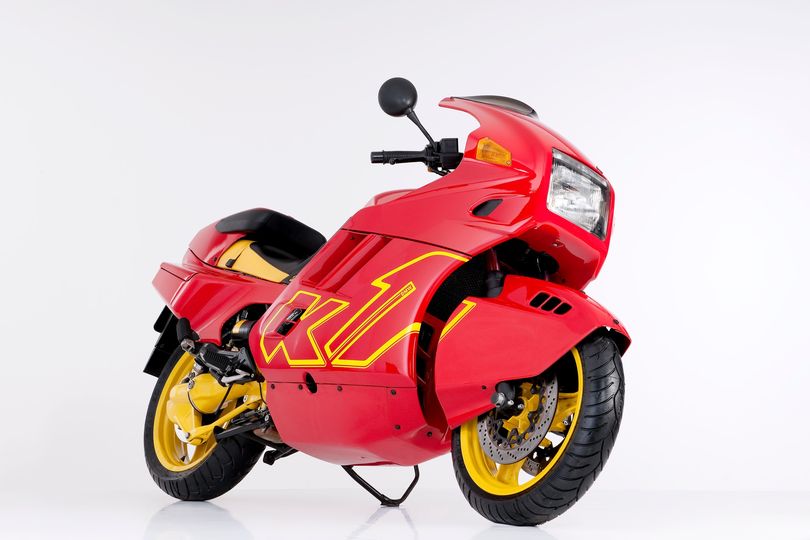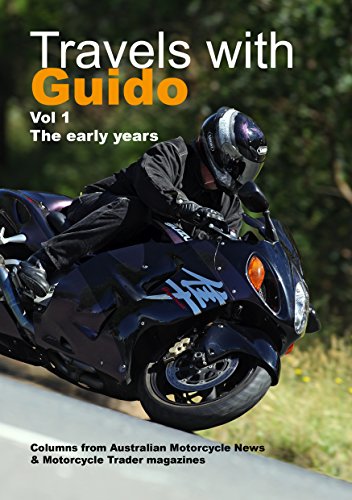Motorcycle Investor mag
Subscribe to our free email news
BMW K1 – bargain classic
(by Ian Falloon, Apr 2022)

The K1's
wild styling represented a different era
Modern motorcycles are
uniformly excellent but generally their style and design
reflects certain
conformity. As a result most motorcycles of a particular
type look remarkably
similar, be it Adventure, Supersports, Naked or Touring.
With developmental
costs so high manufacturers nowadays are reluctant to
take huge marketing risks
but thirty years ago it was quite different. During the
1980s there was
experimentation with 16-inch wheels, anti-dive brakes,
turbochargers, unusual
engine layouts and bold styling.
BMW was always a
conservative manufacturer but they also chose an unusual
path with the
four-cylinder K100 in 1983. In the midst of this
experimentation BMW also
decided the time was ripe for a shaft drive high
performance Superbike, the K1.
They wanted the K1 to stand out from the crowd, and when
it was first displayed
at the Cologne Show at the end of 1988, the K1 shattered
the perception of BMW
as a producer of boring touring motorcycles.
As BMW was committed
to the voluntary 100 horsepower limit for motorcycles
sold in Germany at the
time they concentrated on improving aerodynamics to
obtain high performance.
The large enveloping two-piece front mudguard almost
mated the leading edges of
the seven-piece fairing that joined to a large tail with
miniature panniers.
The drag coefficient
was a remarkable 0.34 with the rider prone, by far the
lowest of any production
motorcycle in 1988. The colour scheme of bright red or
blue with yellow
graphics and highlighting was bold, and almost bizarre.
Totally unlike any
other motorcycle, BMW certainly couldn’t be criticised
for following the crowd.
There was much more to
the K1 than its aerodynamic bodywork. For the first time
on a BMW motorcycle
the cylinder head incorporated four valves per cylinder,
the twin overhead
camshafts acting directly on bucket tappets without
adjustment shims. The
four-cylinder engine retained the K100’s dimensions of
67x70 mm, but the engine
management system was a digital Motronic, similar to
those on BMW cars. The
power was right on 100 horsepower, produced at a
moderate 8,000 rpm.
The chassis components
were also quite radical for a BMW street bike in the
1980s. The tubular steel
frame was much stronger than the K100, and the wide
17-inch wheels were shod
with low profile with radial tyres.
Complementing the
wheels and tyres were upgraded suspension and brakes,
the K1 using the
Paralever swingarm from the dual-purpose GS models, with
a single gas-charged
Bilstein shock absorber. As the swingarm incorporated an
additional U-joint,
the wheelbase stretched out to a cumbersome 1,565 mm.
Italian components
abounded, the front 41.7 mm fork from Marzocchi, the
wheels FPS, and the brakes
Brembo. Four-piston calipers gripped the twin floating
spirally drilled 305 mm
front brake discs and ABS was optional. It all added up
to an impressive
specification, on paper at least.
The K1 was designed
for high-speed use, and the uncompromised riding
position accentuated this. But
with a dry weight of 234 kg the K1 failed in its quest
to offer leading
Superbike performance.
The engine, while
providing a superb broad powerband with excellent fuel
economy, just wasn’t
powerful enough to overcome this weight obstacle. And
although the Paralever
provided a vast improvement in overcoming the inherent
deficiencies of shaft
drive on a sporting motorcycle, it still couldn’t
disguise the considerable
unsprung weight.
Despite these
deficiencies the K1 was the best handling and strongest
performing BMW
motorcycle to date. More suited to high-speed long
distance riding than
outright sports use the K1 remains a formidable machine
in this context.
The radical styling
wasn’t a total success so the colours were toned down
for 1991, with a more
subdued classic black metallic, with silver wheels. But
even this couldn’t save
the K1 and by the end of 1993 it was dead.
Today the K1 remains
an important symbol of BMW’s increasing technological
status that emerged
during the 1980s. Many of its features were landmark at
the time and have
become the norm. The K1 also represents the end of an
era, one before the onset
of sophisticated marketing surveys where bold and brave
designs were created
without knowing if they would be successful.
Because it is so
unique, for those who know and can appreciate it for
what it is the K1 is now
increasingly sought after as a future classic. Expensive
when new, they are
still very cheap and one of the best bargain classics
available.
-------------------------------------------------
Produced by AllMoto abn 61 400 694 722
Privacy: we do not collect cookies or any other data.

Archives
Contact





